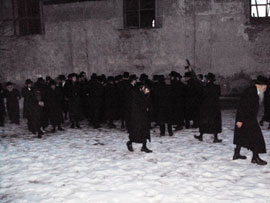A group of Hasid-pilgrims from around the world visits Brody, Lviv region

 On February 20, a group of Hasidic pilgrims, in an amount of about 60 people, came to visit the town of Brody, In Lviv region.
On February 20, a group of Hasidic pilgrims, in an amount of about 60 people, came to visit the town of Brody, In Lviv region.
As reported by ZIK, most visitors are interested in the ruin of Jewish synagogue dating back to XVIII century. Pilgrims walked on all sides of the wall of the temple and prayed for a long time beside one of them.
As it turned out, a group of Hasidic pilgrims included rabbis who are also mentors of Hasidic Jewish community and their assistants from many European countries and the US, particularly, from London and New York.
However, most were citizens of Israel. The purpose of their pilgrimage was visiting Jewish Hasidic sites in Western Ukraine, including the cemetery in the town of Belz, Sokal district, synagogues in Brody and in Zbarazh in Ternopil region, etc.
Previously the Hasidic pilgrims visited neighboring Poland, where they also called on their valued places.
Background: The Synagogue in Brody was built in 1742 (according to the Jewish calendar – the year 5502). This is evidenced by the inscription on the eastern side of the attic, it is also referred to in the description of the synagogues of Zolochiv district as of 1826. The cornerstone of the great synagogue was laid by Yitshak Horowitz, son of Jacob Horowitz from Bolekhiv, whereas its construction was funded by Jacob Yitskovych, a son of Yitshak Krukiver.
During World War II the synagogue suffered significant damage. The first time a memorial was restored in the second half of 1960 and for some time it served as a warehouse, and further remained empty.
In 1991, local authorities tried to restore the building to further adapt it as an art gallery, but the works stopped because of lack of money. Now the temple is in ruins. It lost its northern and southern extensions. From 2006 the vault began to collapse continually. However, the monument is one of the best and largest examples of synagogue building in the world.
The building of the synagogue in Brody is listed in the State Register of monuments under protection number 403.
The monument has national status.









